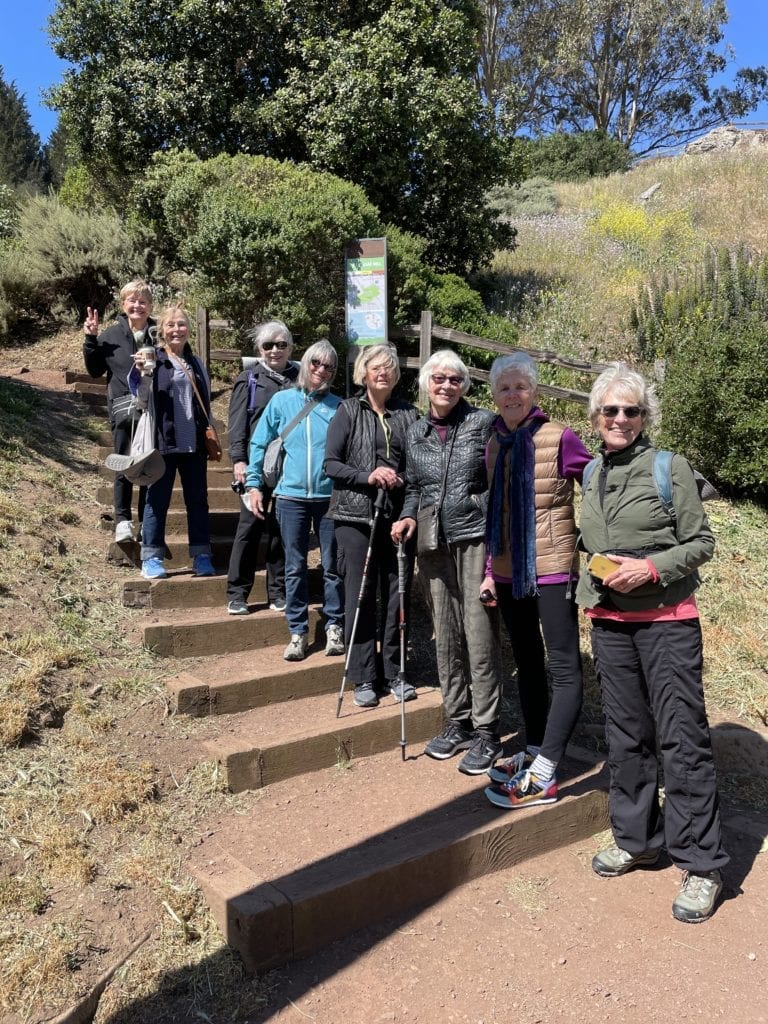
From top to bottom:
Sandy Hunt. Cindy Schaulis, Kay Auciello, Jan Agee, Joan Brennen, Ginger Braski, Nancy Slepicka, Chris Grenne
Glen Park warranted a second look.
On May 21, eight women from the First Friday Walkers assembled at Café XO on Church Street.
“We used to say ‘No repeat tours,’ but that we might repeat a walk one of these days,” long-time FFW Chris Greene told the Glen Park News.
Back in 2017 they had visited Glen Canyon, Crags Court Garden, Penny Lane and Ohlone Way, then gathered for lunch at Tyger’s, a neighborhood constant for comfort food until it shuttered its doors this spring.
The allure of our neighborhood brought them back for a three hour tour on a crisp May morning.
Since its inception in 2012, the FFW have undertaken eight to nine walks a year, walking through Cole Valley, Mission Bay, Heron’s Head Park, and climbing Mt. Davidson. They’ve hiked the Point Bonita Headlands and visited Transbay Terminal’s Salesforce Park.
They’ve been in lockstep for nine years and only last year’s COVID-19 lockdown tossed a roadblock in their path.
During the pandemic they scaled back, taking a February 7 walk to the Oakland Museum and its environs, then on March 16 they moseyed through the Outer Sunset District.
After Governor Newsom declared a state of emergency on March 16, 2020, their shelter-in-place became predictably prescriptive. They enjoyed the company of one another courtesy of Zoom, only resuming ‘real’ walks on November 6 when they wandered through Golden Gate Park’s Botanical Garden.
Their rare Glen Park reboot began at 9:30 a.m., when the eight women set forth along 30th Street, climbing past Whitney, Sanchez, Harper, and Noe Streets and finally to Billy Goat Hill, the first leg of their reprised tour.
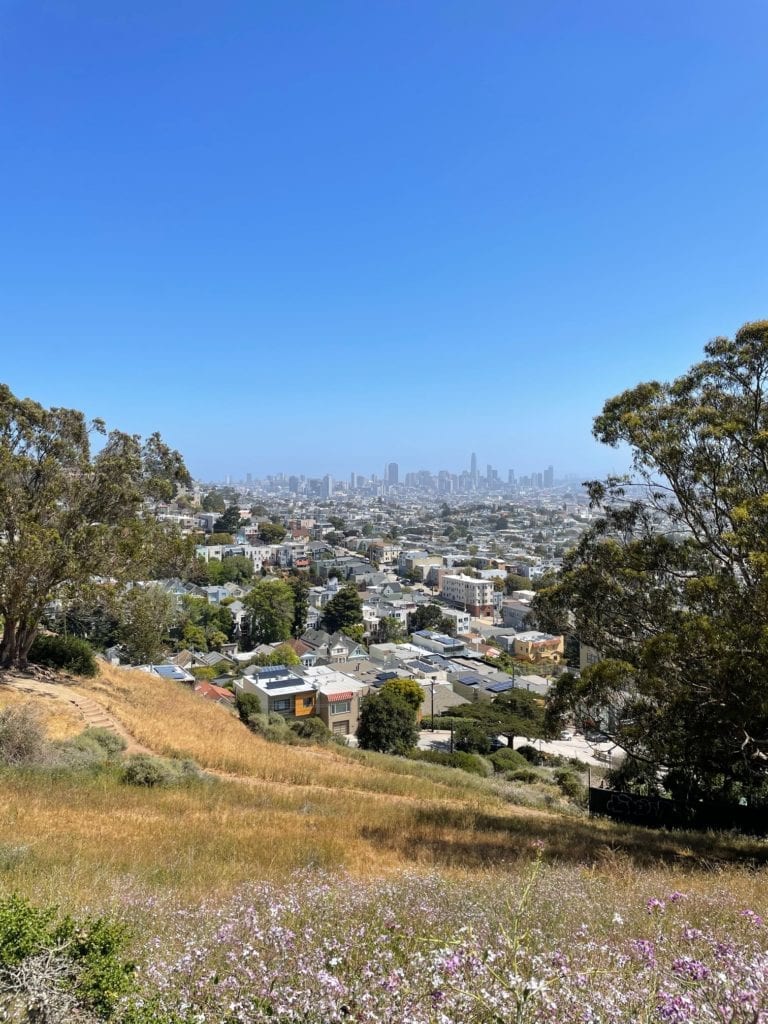
By 10 o’clock, wearing comfortable walking shoes, each woman stood at the corner of 30th and Laidley Streets and took in Billy Goat Hill, once an infamous quarry whose dynamited rock was used for cable car beds and ballasts in ocean going ships.
Over a century before, a Jewish immigrant named Esther Benezra, matriarch of the legendary Tergis family, had tethered her goats on the slope, providing the hill its name.
Around the same time, in 1914, the notorious Gray Brothers blasted rocks that rained down upon neighbors, creating a tsunami of broken windows, flying stones and cracked plaster.
FFW Jan Agee gave the Glen Park News her impressions of Glen Park’s Second Act.
She was fascinated to discover, she wrote, “a gorgeous part of the city full of history and intriguing stories.”
Lots of stories, even more history.
Such as how immigrant Joseph Lococo, a disgruntled quarry employee, shot George Gray because Gray laughed at the laborer when Lococo asked for back wages. After the Italian-American was acquitted of murder on reasons of insanity, a crowd of 100 supporters cheered him as he left the courtroom.
The Glen Park saga had only begun on a day when the ladies would log three miles in a neighborhood most San Franciscans know little of and many don’t even know exists.
Not Ginger Braski, who lives in the Marina.
“San Francisco is a hill town with stunning views, and I love it for that,” she told the Glen Park News, “but the streets we explored on May 21 were brand new to me. I felt like a tourist discovering hidden corners.”
The ladies walked across the street to Dot Adams’s Laidley Street house, an earthquake cottage, one of the hundreds built between September 1906 and March 1907 to shelter some of the at least 16,448 refugees left homeless during the 1906 temblor.
Originally either 14’x 18’ or 10’ x 14’ these dwellings sold for $100 each. They boasted sturdy roofs, fir floors, redwood walls and were painted uniform U.S. Army green.
First placed in Dolores Park, Precita Park and along Presidio Boulevard, the dwellings were subsequently moved and can be found throughout San Francisco.
One of them, Dot Adams’s home, made it to the downside of Billy Goat Hill.
“I found newspapers dated 1906 stuffed in our walls,” said Adams, which she believes offers verisimilitude to her home’s origin story.
Adams’generous COVID-19 mask-making bonafides are well known and replicated nationally. From her Glen Park cottage during the pandemic, she began sewing face masks, going so far as placing them at neighborhood homes on daily walks with her poodle-mix, Monkey.
With the CDC relaxing restrictions, demand for masks is diminishing. So, Dot Adams pivoted.
“Why not make mask scraps into quilts?” she told the FFW.
During the pandemic she created a women’s group to combat the detachment so many felt. Called ‘The Cup of Sugar Club,” it meets once a month via Zoom so members can share a skill or craft or an area of expertise.
“In March, one of the ladies taught us basic quilt making and VOILA!” she said, holding held up a quilt she’d sewn.

FFW Nancy Slepicka left Bernal Heights for Hillsboro, Illinois a few years ago but occasionally finds herself back in San Francisco. One of the original FFW, she didn’t waste time drilling down for her personal epiphany.
“It’s hard to pick just one lasting impression of our tour,” she emailed the Glen Park News, about one single ‘aha’ moment from the May 21 walk. “It’s so fun and uplifting to hear from folks who are passionate about their community.”
Dot’s story reminded her of a group of women in Hillsboro who sewed and shipped more than 27,000 masks worldwide, all financed by local donations.
The woman remained puzzled, though, about the name of the neighborhood since Adams’ diminutive bungalow is a ways from Glen Park’s village, but within eye sight of the upper reaches of Noe Street.
Adams explained that when her husband and she bought their house 19 years ago the realtor called the area Fairmount Heights.
“I call it Glen Park, though,” Adams said definitively.
Whatever a home seller might label it, the first two blocks of Laidley Street look a little different than 90 years ago, when Esther Benezra arrived in San Francisco with her daughter, Sara. Sara later married William Tergis, a Greek-American who’d tramped across the United States avoiding railroad bulls and arrived at Billy Goat Hill in 1938.
“Turk” Tergis eyed Sara Benezra atop her windswept family home at Duncan and Castro Streets and never rode the rails again. He and Sara raised two sons, Jerry and Buck, on Beacon Street, one block above Billy Goat Hill, then moved to their Laidley Street home.
The Tergis house, originally a farmhouse on the first block of Laidley, once belonged to Tillie Olsen, an early feminist and an acclaimed writer of short stories. On March 26, 2021 Olsen became the subject of a New York Times Book Review profile by A.O Scott.
Standing across Laidley Street, the FFW contrasted the modest Tergis dwelling, built around 1910, with the house next to it that looks as if it could become the subject of a Dwell Magazine panegyric.
The mega mansion boasts a red door and entry and is owned by the founder of the online storage site Dropbox.
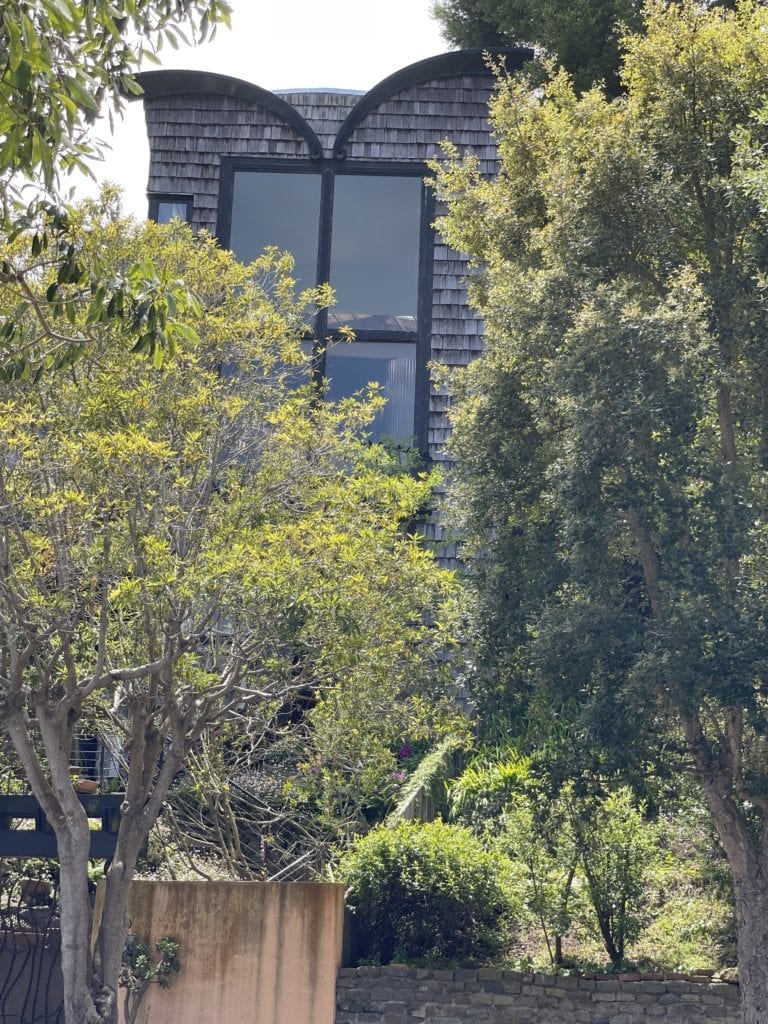
The house’s boxy modernity, however, is consumed by a collage of houses on the 100 block of Laidley, several designed by architect Jeremy Kotas and his partner Skip Shaffer. The Kotas aesthetic extols change over continuity. His signature geometric quirkiness is best represented by 140 Laidley – tagged the owl house, deriving its name from a set of cornice owlish eyebrows that stare quizzically from its top floor.
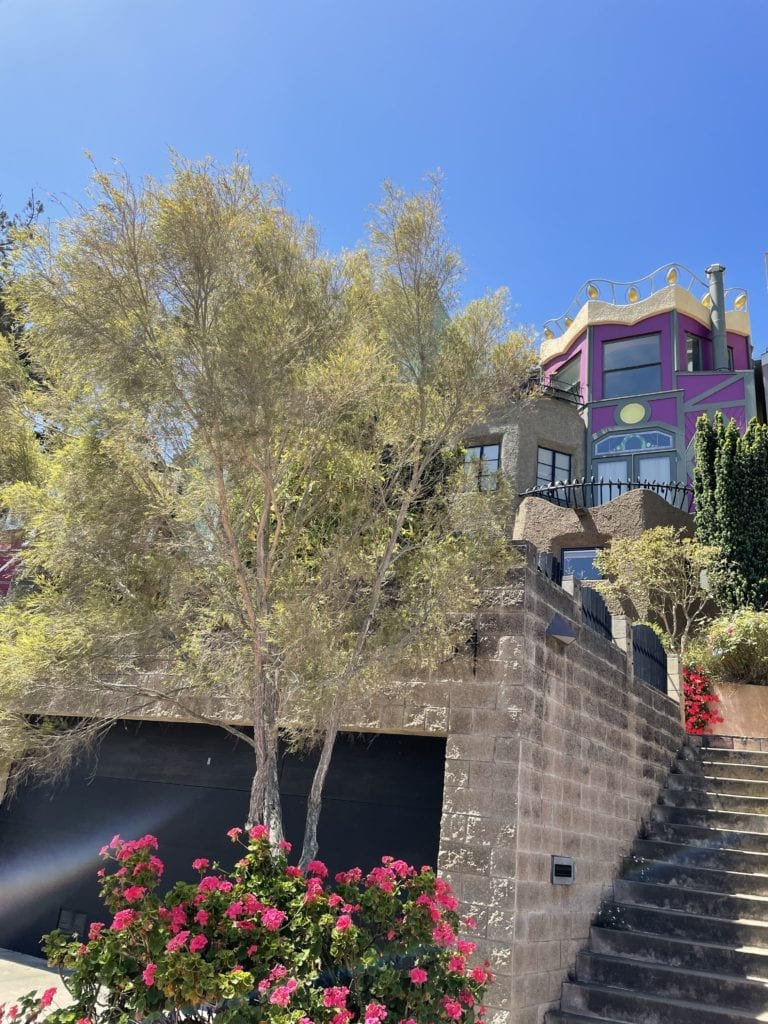
In 2015, the asking price for the owl house was $3.25 million, a sum surely designed to have puzzled Scotsman James Laidley, a State Harbor Commissioner and 19th century namesake for the street the FFW ladies now found themselves.
Jeremy Kotas designed other idiosyncratic Laidley Street houses. Each is a Rorschach test of eclecticism. The women saw for the first time – 134 Laidley Street – a Kotas-Shaffer amalgamation of novelty, eccentricity, whimsy and playfulness.
In 1980 a couple moved to Laidley Street from Bernal Heights and into yet another of Kotas’ houses. It’s the first house Kotas designed from what was one of the working-class cabins found along the Fairmount Tract.
Caught by surprise, the eight ladies were invited inside by the couple kind enough to welcome them into their home. Inside, they were treated to a dwelling built on three levels, boasting a patented Kotas circular stairway descending to a lower level and an astonishing view looking over Noe Valley and Bernal Heights.
“Jeremy Kotas had multiple projects on the block,” their hostess told them. She pointed to Kotas-styled innovations such as her home’s expansive rooms sans claustrophobic walls, some embellished with acute and fanciful angles. The living room decorated with tasteful art segued seamlessly to a dining room, then out onto a deck that overlooks Randall Street backyards, the Sanchez Street hill and Holly Park.
The industrial and unfinished look from exposed ceilings gives the space a sense of expansiveness and it complemented a Shaffer flourish, a set of industrial book shelves adjacent to the fireplace. To test the shelves sturdiness, Shaffer had climbed them – to the delight of the homeowners.
Kotas’ vision was taking a cottage and metamorphizing its miniscule footprint into something unconventional yet exuberant but with coherent facades. He accomplished this while temporarily living in some the houses with his partner while designing their California open floor plans from the mid-1970s to the 1990s.
“Unlike the other McMansions one now sees being built on the street,” the hostess said, “Jeremy houses do not eat up air, space and light.”
She shepherded the women outside, then pointed to 144 Laidley, originally a large, 1929 green farmhouse, and now a candidate for possible demolition.
Its proposed tear down has caused something more than consternation among neighbors. As planned, the house will climb four stories and include a penthouse.
The clock ticking, their walk only half completed and reservations at Cafe Noeteca on Dolores Street made for one o’clock, the ladies thanked their hosts and began strolling up Laidley toward Fairmount Street.
A FFW whispered to a friend that the house’s design and architecture were “unreal,” and “the couple never need take a vacation.”
Before the ladies departed, their hostess added to the neighborhood nomenclature give-and-take, tutoring her visitors that the Fairmount Tract was one of the first developed when people decided the city should expand, so technically, she said, she and her husband lived in the Fairmount.
It may be left to Evelyn Rose of the Glen Park Neighborhood History Project to referee the reality rivalry. Rose penned a lengthy article on her project’s website, framing the genesis “of a slice of San Francisco south of Twin Peaks and east of Mt. Davidson that was once farmland, both rural and idyllic.”
Rose highlights how Jose de Jesus Noe received 4,444 acres from Mexican authorities in 1845 and how, after California was ceded to the United States after the Mexican War, the old Rancho San Miguel was eventually divided into saleable lots by entrepreneurial land speculators.
Rose leaves no doubt about the demographic for the modest lots she described as being advertised after the Civil War as “snug homesteads within easy reach of the business centers … lots situated on a sunny slope of hills perfectly protected from the prevailing winds and having soil of unsurpassed fertility.”
Rose makes it clear the clientele wasn’t the nobs living atop Russian or Nob Hill, but an entirely different class of citizens ready to stretch their budgets atop Fairmount Hill.
“Resident were mainly blue-collar workers who cleaned, built and supported folks in the ‘fancy’ neighborhoods in town. There occupations in 1868 included carriage makers, stablers, bakers, painters and men working in the building trades.”
The ladies continued along Laidley, doglegging past still another paean to exaggerated modernism, this time a Goliath-like skeleton of scaffolding shrouded behind netting.
The nascent structure covered two steep lots on the upside of Fairmont Hill. It was on this slope, in the 1790s, Mission Dolores cattle grazed upon wild grasses such as California fescue, broom and blue wild rye on their way to the Presidio to be butchered and to feed Spanish soldiers quartered there.
The ladies reached the corner of Miguel and Bemis Streets, then angled left a few yards until arriving at Amatista Lane. The “lane” is actually fewer than 100 cement steps that end at recently refashioned Fairmount Plaza, a postage stamp garden of 900 native plants first put in place on January 11 and February 15, 2020.
Once atop the plaza, which demarcates the frontier of lower Diamond Heights from Fairmount Heights, the ladies used box steps and paths to reach the plaza’s pinnacle. Here they were treated to yet another breathtaking view that looked south not east.
Taking time to sit on boulders, they collected themselves, chatting about grandchildren, pandemic thwarted travel plans and pollinators hovering above drought tolerant plants that offer nectar and fruit – shrubs such as yarrow, coffeeberry, and gooseberry that supply sustenance to nesting and migratory birds that take respite in one of the newest Recreation and Park Department natural area sanctuaries.
Regaining Miguel Street, they headed to the Miguel Street Garden.
In 2007 Richard Linder, who has lived on Miguel Street for 28 years, created on a cement wall a fantastical alchemy of glass, marble, copper and clay that has become 11 years later a destination for those who love serendipity bundled together with public art.
The FFW were beguiled.
Richard Linder’s Miguel Street ceramic relief sculptures are named “Mudpuppy,” “Icarus,” and “Shaman,” and each dramatically pulled in the ladies. His renditions are derived from discarded pieces of kilned clay from his Noe Valley studio and glass, shell and marble effluence gathered at seashores and rummaged in thrift shops.
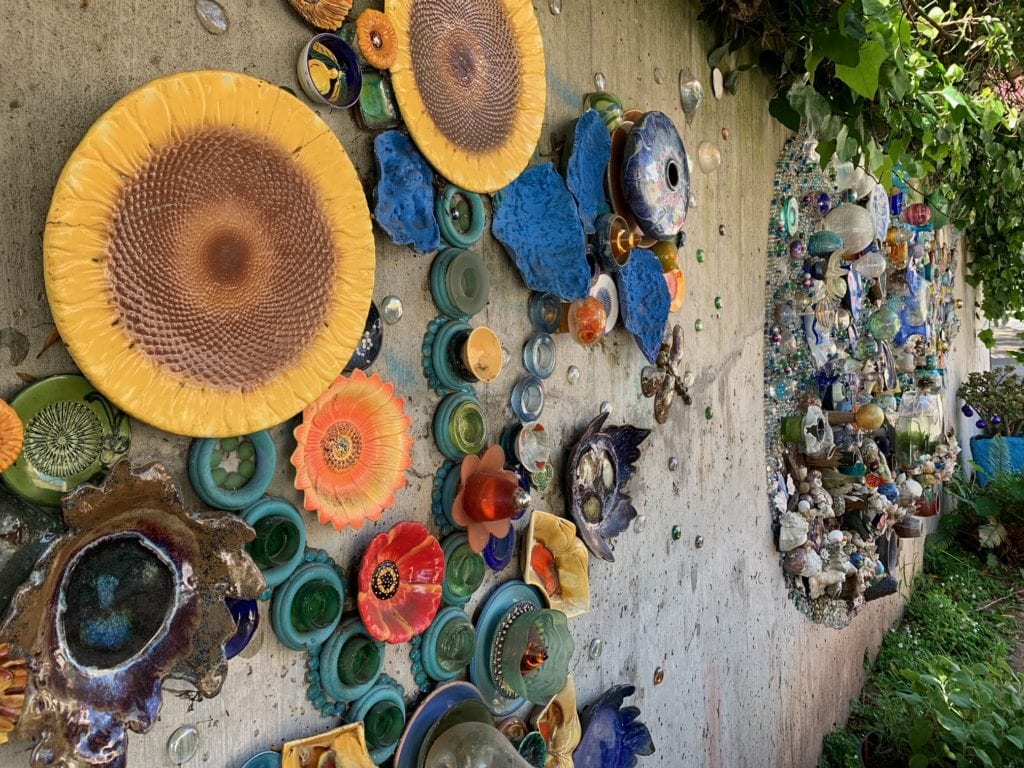
Linder strolled over and greeted the women. He wore shorts, a long-sleeved yellow shirt and a pair of leather sneakers.
Like the couple on Laidley Street who’d opened their front door to the women, Linder happily answered their questions.
Art must be shared he told them.
Walker Cynthia Schaulis was entranced.
“I’m always fascinated to see the ways in which residents create community art in all corners of the City,” she said.
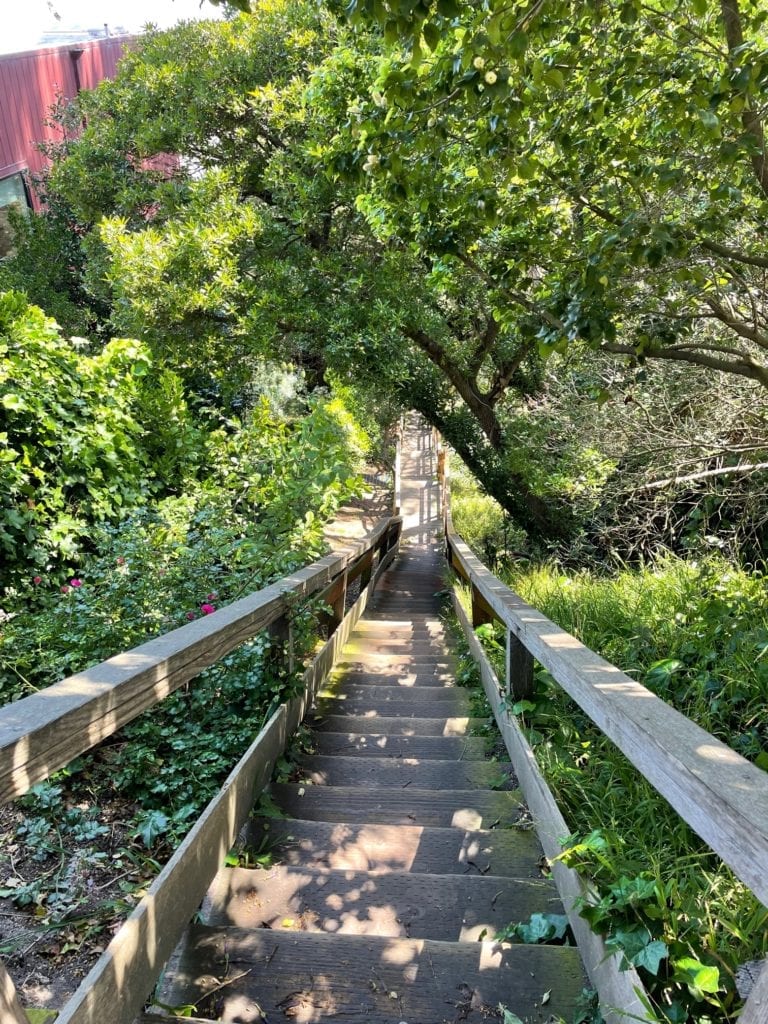
Miguel Street transitions to uphill Beacon Street and the ladies continued until they reached the Harry Street stairs, a camouflaged easement made up of 258 uneven, not-up-to code steps.
The upside of Billy Goat Hill lay only a few yards away, and across the street stood one of the earliest Tergis family homes.
A painted eagle could be seen embossed on the house’s front. Sara Benezra built the home in 1935 from scrap lumber she’d rifled from Glen Canyon. The house is where her sons, Jerry and Buck, lived and played as 14 and 10-year-olds in the 1950s.
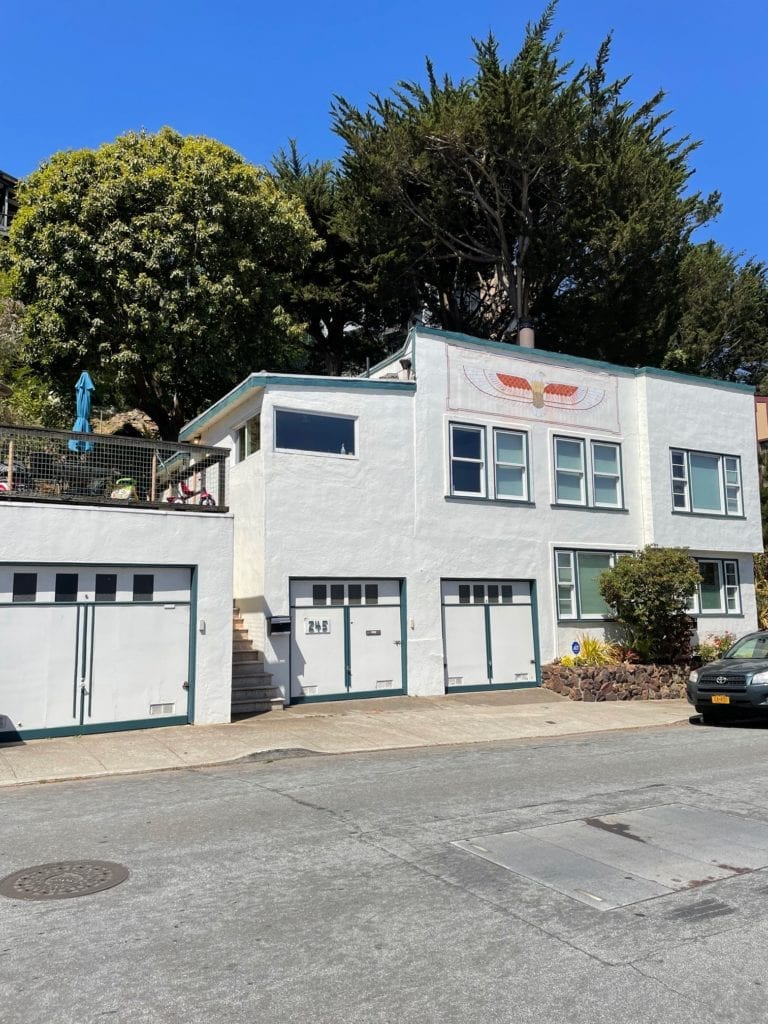
Beacon Street was then little more than a rutted dirt road.
Buck Tergis left us on April 5, just a few days after his 79th birthday, survived by his wife Judy, who’d conceived the east facing eagle as an original peoples’ symbol of peace, and by four adult children and two grandchildren.
Before the FFW descended the Harry Street stairs, they passed two men tinkering with a stalled car. Friendly, one inquired if the ladies intended walking down the Billy Goat Hill box steps or the Harry Street stairs.
One of the men made a doleful nod across the street to the Tergis childhood home.
We’ll not see Buck’s likes again.
You couldn’t mistake Buck. He was seen daily walking his dog, Monty, dressed in his familiar buffalo plaid flannel, his lived-in Levi’s, his worn-down sandals and his knit beanie.
“Buck was unique,” Judy Tergis telephoned the Glen Park News on June 4. “He was always outdoors, in the yard working with plants and moving soil.”
The eight ladies had walked the perimeter of Billy Goat Hill earlier that morning and had seen evidence of Buck’s skill. His rock walls shore up the base of the hill where his grandmother brought her goats to graze and his succulents braid its hillside.
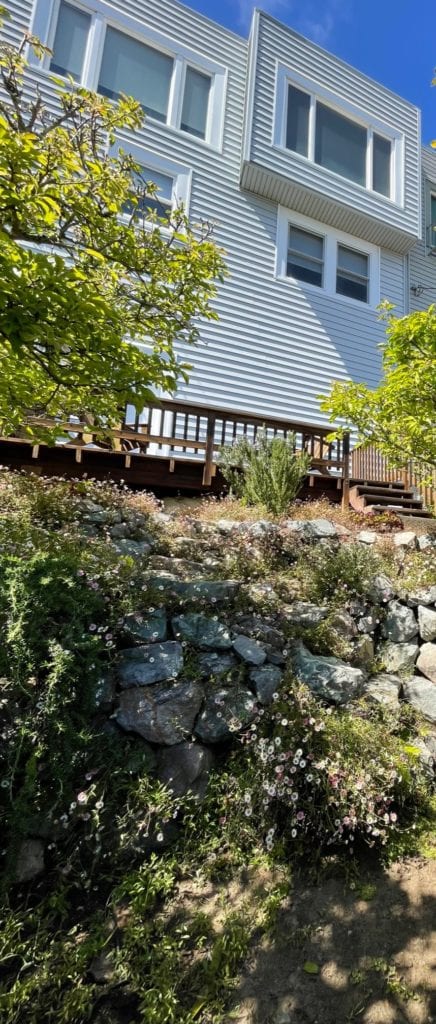
The Tergis clan had driven to Market Street in the mid-1930s when the thoroughfare was repaved and trolley tracks were positioned. They pulled up the stones, placed them in the family Model T and brought them back to Beacon Street.
Throughout surrounding hilly neighborhood backyards one can find Buck Tergis rock walls. In 2001, Buck, at 59 and a former college weightlifter, hefted 50-pound rocks, one at a time, to two within sight of Glen Park Elementary School.
Then he fitted each rock precisely among a palisade of others he’d deposited. In the ensuing years those rock walls have not budged.
One of the walkers later reflected in email on the Norman Rockwell-like affection Glen Park people showed to one another.
“I was struck by the sense of neighborhood pride as we walked around,” Joan Brennan wrote. “The wonderful folks who spoke with us all oozed it and their warm feelings for the neighborhood.”
The FFW were now on their last lap. It was half past noon and they’d circled the neighborhood in three hours. At the crest of the Harry Street stairs they began their single file descent. Soon they were surrounded by one of the best kept secrets in San Francisco, a leafy and verdant ode to rusticity that is unequaled by any other City hidden stairway walk.
Listed at its earliest in a 1868 city directory, Harry Street by 1916 was described as a cow path. The steps grace the cover of an edition of Adah Bakalinsky’s Stairway Walks in San Francisco, and was voted the best stairway walk in San Francisco by the Bay Guardian.
Halfway down the stairs the ladies came upon two houses on each side of the stairway. They stopped at 30 Harry Street, a 1904-built cottage that once housed Daniel Oppenheim who operated the Urban Safari tourist busses. The existential question challenging the Oppenheim family who lived 126 steps above Laidley Street. Almost every week Oppenheim’s daughter would ask, “Are we carrying groceries up?”
But looking across the stairs at 47 Harry Street and at a 1929 Tudor house built by a SFFD captain and surrounded by lavender, jasmine, cypress and redwoods, it really wouldn’t matter.
Back again on Laidley Street the ladies returned to 30th Street and retraced their earlier steps, arriving exactly at the time of their one o’clock lunch reservation.
A few days later, from her North Beach home, Sandy Hunt reflected on her rucksack ramble.
“My cell phone said we walked 18 floors, and I never thought about climbing at any moment I was so mesmerized.”
The FFW had asked Glen Park for a curtain call and they were more than delighted with its encore.
“I now live in Davis,” wrote Jan Agee, “but I definitely left my heart in San Francisco.”